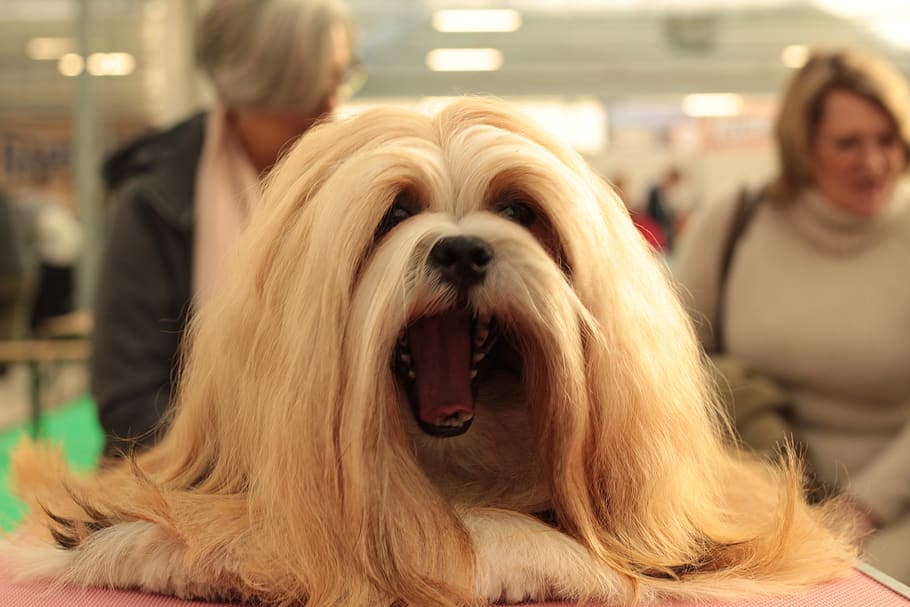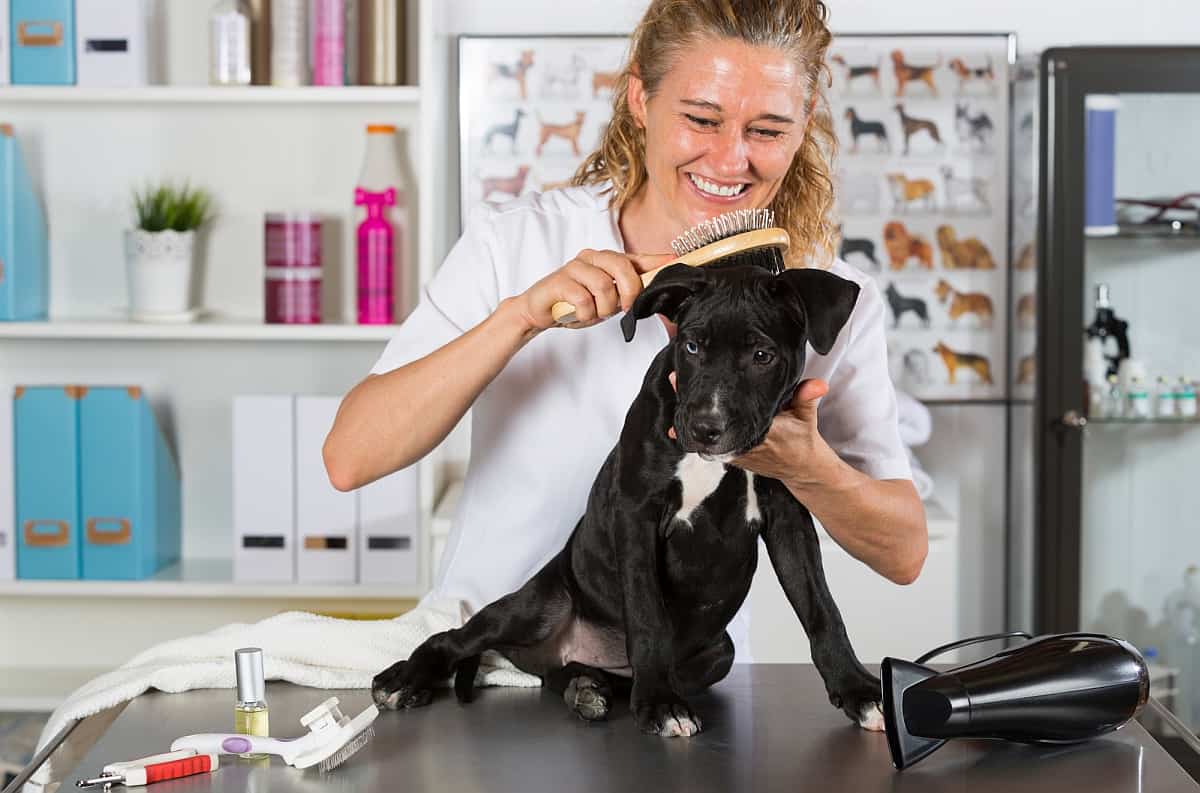It’s a dog-eat-dog world out there, and with how busy we are nowadays it can be difficult to find the time to drop everything and go take your pup for a haircut. After all, the average person has less than 5 hours of downtime a week!
Thankfully, grooming your dog at home is easy as pie! This article will give you step-by-step instructions on how to groom your dog from head to tail.
What all goes into dog grooming? Read on to find out!

Groom Your Dog at Home
Brushing your dog at home needs various brushes, including bristle brushes for removing mats and dead hair; slicker brushes to polish droopy coats and remove dead hair.
Dandruff can be a problem. Brush your dog so that dandruff falls off. It is normal for some breeds to have more dandruff than others, but you can keep it under control by brushing regularly.
The specific type of equipment needed depends on the length and texture of your dog’s coat. Longhaired breeds need pin brushes, which have long, rounded metal pins pointed at one end. Some longer-haired breeds will also require a slicker brush for frequent grooming. Dogs with shorter coats only need to be required to brush occasionally to get rid of excess fur.
Check for Burrs
When working to groom your dog, be sure to check for burrs along with other plant stragglers. Next, look for any mat. Mats tend to form behind the ears and under the legs; and any cuts or scrapes on their skin.
It helps if you wet the dog with warm water, apply a mild shampoo formulated for dogs from the neck back, and scrub vigorously. Rinse thoroughly with warm water and towel dry. Comb or brush as required.
Pretty Nails
The safety and well-being of your dog’s feet rely on short nail growth. Long nails can cause foot pain or damage, as they hit against sidewalks or other hard surfaces. The most common danger is cracking at the base of a nail, where vital blood vessels and nerves are located.
Cutting the quick is dangerous, and bleeding may not stop by itself. If you’re worried about clipping your dog’s nails, visit a groomer or animal clinic for help.
Avoid Pulling Hair
How can you keep from pulling your dog’s hair?? By using a quality dog bathing brush, and keeping your clippers sharp. The proper dog grooming equipment should always be kept sharp because like cutting your hair, a sharp scissor is less likely to tug and pull on the skin. Keep them sharp so they can slice through tough spots by using the scissor’s top blade.
When trimming your pets’ fur, go slowly and gradually. When cutting your dogs nails, take care not to cut too quickly
When you groom your dog at home, it can take a long time given the hair’s natural growth pattern. To help avoid potential challenges, use an article of clothing to cut in the direction you want it to grow to ensure that when new hairs come back they are consistent with existing hair on your pet.
Quiet Grooming Tips
Moving on, loud noises are one of the top reasons dogs experience anxiety.
Depending on your dog, you may already know how loud noises can surprise or dismay them.Test different clippers and get the one that makes the least noise; it will make the experience better for both of you. While grooming, it is important to keep all outside distractions to a minimum; such as keeping others away from your pet, whether they be other people or other animals.
Using a soft damp cloth, wipe around your dog’s eyes. Dirt and crust can collect in this area, leading to an infection. Check the eyes for any signs of redness or swelling while you’re there; dry eyes can lead to irritation in your pup. Keep the room your pup is in humid enough to avoid drying out their eyes; artificial tears might also be necessary if needed. Consult with a vet before administering eye drops; do so only if it’s been okayed by them first.
Groom Your Own Dog Based off Coat Type
There are over 300 different dog breeds, and your special pup’s genealogy affects its fur. To groom your dog at home, you’ll need to know how to identify his coat type.
You can find out if they have a single-layered or two-layered coat by running your fingers over his fur. If it feels like one layer of hair, then they’re likely not shedding. One layer is considered low maintenance with grooming needs throughout the year.
However, if there’s an obvious difference between how thick the underside of the fur is and how thin on top, this means they shed heavily during seasons where temperatures are coldest which requires more frequent brushing for loose hairs not to accumulate all over your house. Dogs who have longer coats require more attention when trimming also since there’s more to tend to.
If you’ve been debating whether or not to groom your dog yourself, be sure to consult a professional before actually jumping into it. Professional groomers have extensive experience working with specific breeds of dogs and will be able to walk you through the specifics of that breed’s coat type and the appropriate tools for grooming it.
Tips for Grooming Long Haired Dogs

Long hair dogs take a little more time and patience than short-haired breeds to groom. But with the right tools, knowledge of how each dog’s coat sheds, how often they need grooming, and how much work is required for specific types of coats, you can have success.
For example, you should brush your long-haired dog with a slicker brush. Next, use the rake comb to remove undercoats and loose hairs from double coats, such as Curly-Coated Retrievers or Newfoundlands.
Clip thick areas like leg feathers and chest/belly hair only when they are matted. To avoid matting after trimming these excessive accumulations of fur, use scissors rather than clippers on this area. If you do need to shave overgrown armpits, be sure to let them grow back in fully (approximately six weeks) before clipping again so that no stubble is present at the start of the grooming process next time!
Handling Mats
If you have a long-haired dog with mats in its coat, we recommend brushing off any loose hair first before using scissors on those matted sections of fur. If they are just starting to get tangled up but not too bad yet, use a mat comb instead for easier removal! Once per month is all it takes to keep your pet looking fresh year-round – don’t forget about that tail!! Make grooming an enjoyable bonding experience for both of you by making it into something fun rather than a hassle.
Long Haired Styles
Are you wondering what style to give your long-haired dog? The right choice will depend on the texture of the coat.
For instance, let’s say you have a Longhaired Bichon Frise.
The longhaired Bichon Frises have a dense, curly coat. They are mainly white and powdery but can also be found in apricot, cream, or any other color to suit your taste. The curls make this coat very easy to maintain because it tends not to tangle as much due to how the hair is cuticle lays on top of each other with no directionality. A simple brushing will go a long way for these dogs!
Other long haired’s include:
- Shih Tzu
- Maltese
- Lhasa Apso
Remember to always use a slicker brush. A slick type of brush has metal bristles that can penetrate deep into your dog’s coat and remove loose hair and dirt without damaging their skin. It doesn’t have any sort of handle on it so make sure you grip it with one hand while using the other to guide how much fur comes out.
When used properly, the shaggy growth should be smoother after brushing through them. Soft brushes are great for sensitive dogs who don’t enjoy being touched too hard because they will just move with each brushstroke.
Playful Summer Stripes
For pet owners looking for a summer style with very little work, striped fur may be your answer. It’s easy to maintain compared to cuts or shaves which need regular maintenance every few weeks at home grooming appointments. To get these two-toned stripes, make sure your dog is good and dirty before you wash them off!
Tips for Grooming Short Haired Dogs

Does your dog have short hair? If so then it’s important to brush them every day. When you groom your pup, make sure that you start at the neck and work yourself down their body, taking special care around sensitive areas like near the eyes or underarms.
For short-haired coats, avoid dog brushes with metal bristles or pins. Next, rub the coat with a towel or washcloth and then use either a rubber curry comb (this is similar to using conditioner with human hair) or just some old-fashioned fingers.
Do not pull hard on the fur when grooming; this could cause damage. Instead, gently massage their skin to loosen mats and tangles so that they can be brushed out more easily than if you were pulling at it all by hand.
Brushing should take no longer than five minutes for short-haired dogs and about fifteen minutes for long-haired breeds who don’t require daily brushing but still have an issue with matting throughout the day.
Styles for dogs with short hair are easy to do at home and you won’t have to spend a fortune on pampering your pet.
Dogs with short hair will need a brush, maybe some trimming scissors, nail clippers, and a toothbrush. The grooming process is the same as for dogs who have long hair but usually takes less time because there’s not so much fur involved!
When brushing them make sure that you use just enough pressure in order not to pull out any of their shedding hairs or hurt them in any way. You can also try using an undercoat rake which helps remove the dead coats from their skin without hurting them like when you’re doing it by hand.
Overcoming Dog Grooming Anxiety
How can you guarantee your dog will stay calm while you’re grooming them? There are many ways to do this depending on your dog’s temperament and personality. For instance, don’t give them too much at once.
Let grooming be a gradual process so they have time to get used to grooming. Start by just brushing their fur without getting up close or touching sensitive areas like ears or genitalia. Once they are comfortable with that, start trimming around those regions gradually approaching more intimate areas.
The same goes for bathing; don’t jump right in! Let them sit in water first before starting scrubbing and conditioning cream work its magic deep into their skin folds and coat follicles. It may also make sense to groom in stages. For instance, you can start with brushing, then move on to nail trimming and teeth care.
Next, teach them the word ‘stop’. For grooming to be successful, you need your dog’s cooperation. You should therefore establish what “Stop” means so that they know if they are doing something wrong or if it’s time to stop altogether.
When you say this word, make sure that their attention is focused on you by looking at them directly while speaking and using a firm voice tone (not angry). Once they understand what these words mean from hearing them frequently during grooming sessions, use these cues as an opportunity to teach other commands like sit or lay down.
Successfully Groom Your Dog
Grooming your dog at home is easy. All you need are the right tools and a little patience to get started. If at-home grooming sounds like something that would be beneficial for you, then make sure you take some time today to learn what type of coat your dog has. Next, you can buy the appropriate brush or comb in advance.
After all, it’s much easier than running around trying to find one on the fly when you need it most! When you take the time to do things right, we’re sure you’ll have a great time when you groom your dog. For more advice, explore our site.
